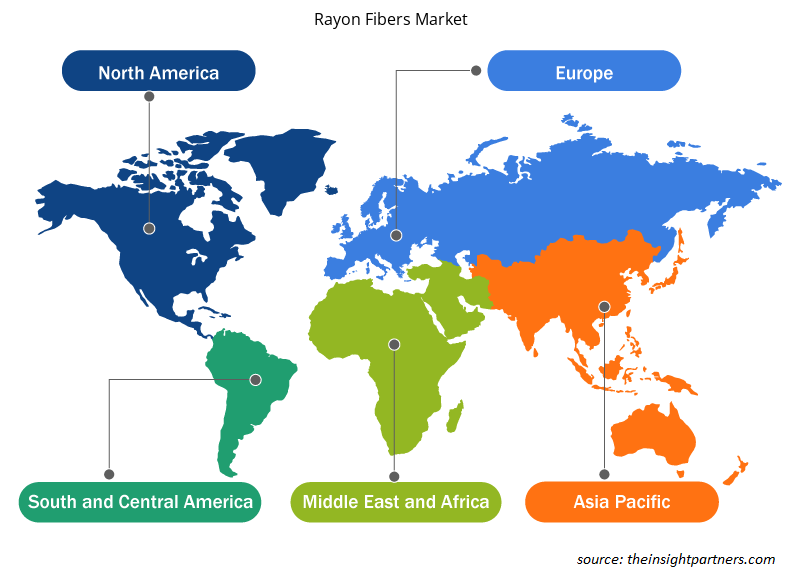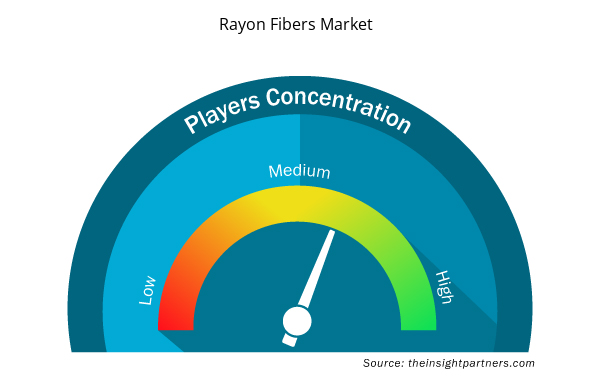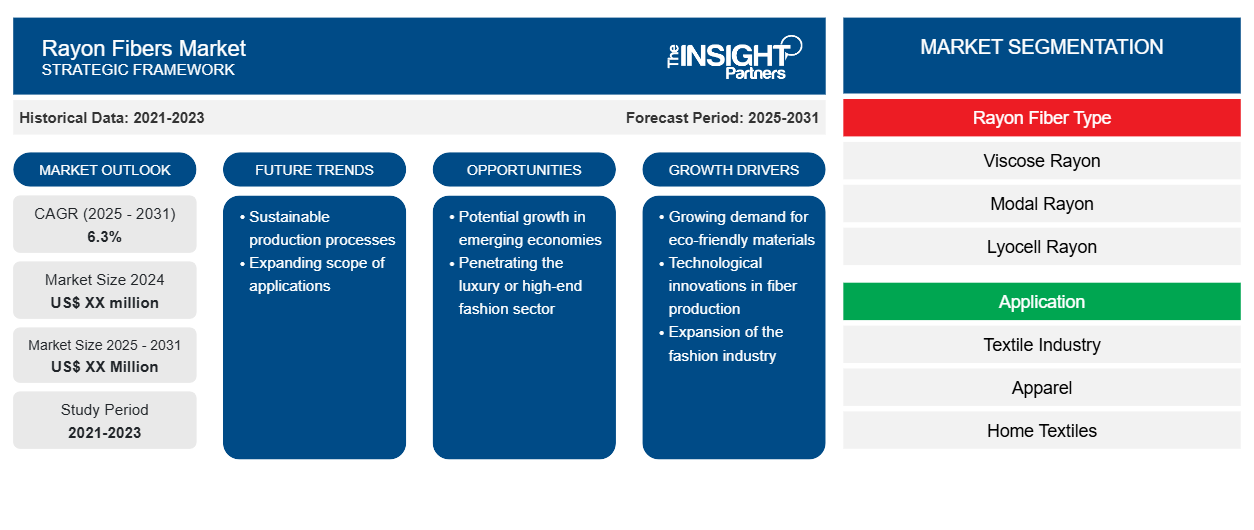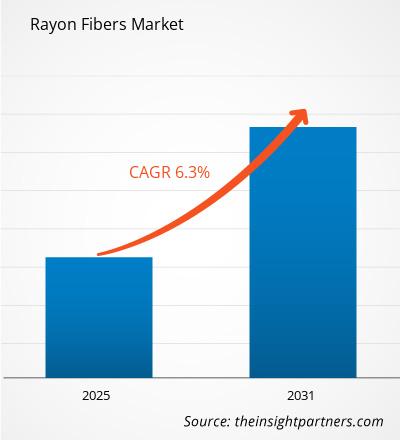Se espera que el mercado de fibras de rayón registre una CAGR del 6,3 % entre 2023 y 2031, con un tamaño de mercado que se expandirá de US$ XX millones en 2023 a US$ XX millones en 2031.CAGR of 6.3% from 2023 to 2031, with a market size expanding from US$ XX million in 2023 to US$ XX Million by 2031.
El informe está segmentado por tipo de fibra de rayón (rayón viscosa, rayón modal, rayón lyocell, rayón cupro y otros). El informe está segmentado además por aplicación (industria textil, indumentaria, textiles para el hogar y otros). El alcance del informe cubre cinco regiones: América del Norte, Europa, Asia Pacífico, Medio Oriente y África, y América del Sur y Central y los países clave de cada región. El análisis global se desglosa aún más a nivel regional y por países principales. El informe ofrece el valor en USD para el análisis y los segmentos anteriores.lyocell rayon, cupro rayon, and others). The report is further segmented by application (textile industry, apparel, home textiles, and others). The report scope covers five regions: North America, Europe, Asia Pacific, Middle East and Africa, and South and Central America and key countries under each region. The global analysis is further broken down at the regional level and major countries. The Report Offers the Value in USD for the above analysis and segments.
Propósito del Informe
El informe Rayon Fibers Market de The Insight Partners tiene como objetivo describir el panorama actual y el crecimiento futuro, los principales factores impulsores, los desafíos y las oportunidades. Esto proporcionará información a diversas partes interesadas del negocio, como:
- Proveedores/fabricantes de tecnología: Para comprender la dinámica cambiante del mercado y conocer las oportunidades potenciales de crecimiento, lo que les permitirá tomar decisiones estratégicas informadas.
- Inversionistas: Realizar un análisis exhaustivo de tendencias sobre la tasa de crecimiento del mercado, las proyecciones financieras del mercado y las oportunidades que existen en toda la cadena de valor.
- Órganos reguladores: Regular las políticas y vigilar las actividades del mercado con el objetivo de minimizar los abusos, preservar la confianza de los inversores y defender la integridad y estabilidad del mercado.
Segmentación del mercado de fibras de rayón
Tipo de fibra de rayón
- Rayón viscosa
- Rayón modal
- Rayón lyocell Rayon
- Rayón cupro Rayon
Solicitud
- Industria textil
- Vestir
- Textiles para el hogar
Personalice este informe según sus necesidades
Obtendrá personalización en cualquier informe, sin cargo, incluidas partes de este informe o análisis a nivel de país, paquete de datos de Excel, así como también grandes ofertas y descuentos para empresas emergentes y universidades.
- Obtenga las principales tendencias clave del mercado de este informe.Esta muestra GRATUITA incluirá análisis de datos, desde tendencias del mercado hasta estimaciones y pronósticos.
Factores impulsores del crecimiento del mercado de fibras de rayón
- Demanda creciente de materiales ecológicos: a medida que aumenta la demanda de materiales sostenibles y ecológicos, las fibras de rayón raras ganan más atención. El rayón es biodegradable y renovable, especialmente si se obtiene a partir de pulpa de madera gestionada de forma sostenible o de fuentes vegetales alternativas. Por lo tanto, es mucho más sostenible que las fibras sintéticas como el poliéster o el nailon, que se basan en petróleo y no son biodegradables. El esfuerzo cada vez más consciente de la industria textil mundial hacia prácticas más sostenibles ha generado un interés significativo en las fibras de rayón raras, que se producen más con menos residuos químicos y una menor huella de carbono.eco-friendly materials: As demand for sustainable and eco-friendly materials rises, rare rayon fibers gain more attention. Rayon is biodegradable and renewable, especially if it is obtained from sustainably managed wood pulp or alternative plant sources. Hence, it's much more sustainable than synthetic fibers like polyester or nylon, which are based on petroleum and non-biodegradable. The increasingly conscious effort of the global textile industry toward more sustainable practices has generated significant interest in the rare rayon fibers, which are produced more with less chemical waste and a smaller carbon footprint.
- Innovaciones tecnológicas en la producción de fibras: Las nuevas tecnologías en la producción de fibras seguirán impulsando el crecimiento en el mercado de fibras de rayón poco comunes. Por ejemplo, el método de producción de rayón de circuito cerrado mediante el proceso Lyocell sigue reduciendo el daño ambiental asociado con el rayón mediante el reciclaje de agua y disolventes. Se espera que este tipo de innovación respalde el uso de fibras de rayón poco comunes en diversas aplicaciones industriales, en particular en aplicaciones textiles, debido a la creciente demanda de fibras de alto rendimiento que sean respetuosas con el medio ambiente. Además, las propiedades de las fibras de rayón se están mejorando mediante nuevas técnicas de mezcla, lo que hace que las fibras sean más versátiles para aplicaciones en una amplia gama de productos.Lyocell process closed-loop method of rayon production continues to reduce the environmental damage associated with rayon through the recycling of water and solvents. This kind of innovation is expected to support the use of rare rayon fibers in various industrial applications, particularly in textile applications, due to the rising demand for high-performance fibers that are environmentally friendly. Furthermore, the properties of rayon fibers are being improved through novel blending techniques, making the fibers more versatile for applications across a wide range of products.
- Expansión de la industria de la moda: Los mayores consumidores de fibras de rayón son la industria de la moda, además de los tipos raros y especiales como el modal y el lyocell. La creciente conciencia del consumidor sobre el impacto ambiental de la moda rápida está impulsando a las marcas a utilizar materiales más sostenibles, en cuyo contexto las fibras raras de rayón entran en juego. Las fibras raras de rayón brindan una sensación lujosa y una textura suave, tan deseadas en la ropa de lujo de alta costura y las gamas de ropa premium, que se están volviendo aún más demandadas a medida que aumenta la demanda de productos de lujo sostenibles en el mercado.lyocell. The increasing consumer awareness of the environmental impact of fast fashion is pushing the brands to use more sustainable materials, in which context the rare rayon fibers come into the fray. Rare rayon fibers give a luxurious feel and soft texture, so desired in high fashion luxury wear and premium clothing ranges, which is becoming even more in demand as demand increases for sustainable luxury products in the market.
Tendencias futuras del mercado de fibras de rayón
- Procesos de producción sostenibles: Los procesos de producción de circuito cerrado son una de las tendencias más destacadas en el mercado de las fibras de rayón. Las empresas están trabajando para minimizar la huella ambiental de la producción de fibras de rayón mediante el reciclaje de agua y disolventes, especialmente en la producción de lyocell, un tipo de rayón hecho a partir de pulpa de madera. Estos procesos reducen el uso de agua y la descarga de sustancias químicas al medio ambiente, en línea con el impulso mundial a favor de prácticas de fabricación más sostenibles.lyocell, a type of rayon made from wood pulp. Such processes reduce water usage and chemical discharge into the environment, in line with the global drive for more sustainable manufacturing practices.
- Ampliación del ámbito de aplicación: mientras que las fibras de rayón se utilizaban únicamente en la industria textil, hoy en día tienen un mayor uso en las industrias automotriz, médica y de decoración del hogar. Las fibras de rayón se han utilizado cada vez más en los interiores de los automóviles, que son más livianos y económicos en comparación con los materiales sintéticos. La naturaleza hipoalergénica del rayón lo convierte en un producto ideal para usar en apósitos para heridas, prendas quirúrgicas y vendajes en productos médicos.
Oportunidades de mercado para las fibras de rayón
- Crecimiento potencial en economías emergentes: existen perspectivas de crecimiento significativas para las fibras de rayón poco comunes en mercados emergentes como China, India y Brasil. Debido a la rápida industrialización y al aumento de los ingresos disponibles, la demanda de moda sostenible está aumentando, junto con el deseo de materiales de alta calidad. Esta expansión de las industrias textil y de la moda en estos mercados es una oportunidad de oro para que los fabricantes de fibras de rayón poco comunes ingresen a nuevos mercados con una demanda de consumo cada vez mayor de dichos productos.
- Penetrar en el sector de la moda de lujo o de alta gama: existe un gran potencial en los sectores de la moda de lujo y sostenible a través de fibras de rayón muy poco comunes, como el modal y el lyocell. Con las marcas y los diseñadores de moda de primera clase comprometiéndose firmemente con el uso de materiales sostenibles, es seguro que habrá un gran mercado para la creación de alianzas estratégicas con productores muy poco comunes de fibras de rayón. Esto se traduciría en una gran visibilidad en términos de marketing del mercado con una mayor demanda de textiles ecológicos de alta calidad.lyocell. With top-class fashion brands and designers strongly committing themselves to sustainable material usage, there is bound to be a large and huge market for the creation of strategic alliances with very rare producers of rayon fibers. This would translate to high visibility in terms of marketing of the marketplace with more demand for highly quality ecologically friendly textiles.
Perspectivas regionales del mercado de fibras de rayón
Los analistas de Insight Partners explicaron en detalle las tendencias y los factores regionales que influyen en el mercado de fibras de rayón durante el período de pronóstico. Esta sección también analiza los segmentos y la geografía del mercado de fibras de rayón en América del Norte, Europa, Asia Pacífico, Oriente Medio y África, y América del Sur y Central.

- Obtenga datos regionales específicos para el mercado de fibras de rayón
Alcance del informe de mercado de fibras de rayón
| Atributo del informe | Detalles |
|---|---|
| Tamaño del mercado en 2023 | XX millones de dólares estadounidenses |
| Tamaño del mercado en 2031 | US$ XX millones |
| CAGR global (2023 - 2031) | 6,3% |
| Datos históricos | 2021-2022 |
| Período de pronóstico | 2024-2031 |
| Segmentos cubiertos | Por tipo de fibra de rayón
|
| Regiones y países cubiertos | América del norte
|
| Líderes del mercado y perfiles de empresas clave |
|
Densidad de los actores del mercado de fibras de rayón: comprensión de su impacto en la dinámica empresarial
El mercado de fibras de rayón está creciendo rápidamente, impulsado por la creciente demanda de los usuarios finales debido a factores como la evolución de las preferencias de los consumidores, los avances tecnológicos y una mayor conciencia de los beneficios del producto. A medida que aumenta la demanda, las empresas amplían sus ofertas, innovan para satisfacer las necesidades de los consumidores y aprovechan las tendencias emergentes, lo que impulsa aún más el crecimiento del mercado.
La densidad de actores del mercado se refiere a la distribución de las empresas o firmas que operan dentro de un mercado o industria en particular. Indica cuántos competidores (actores del mercado) están presentes en un espacio de mercado determinado en relación con su tamaño o valor total de mercado.
Las principales empresas que operan en el mercado de fibras de rayón son:
- Acordis
- Grupo Aditya Birla
- Tecnología Aoyang
- Compañía química Eastman
- Industrias Grasim
Descargo de responsabilidad : Las empresas enumeradas anteriormente no están clasificadas en ningún orden particular.

- Obtenga una descripción general de los principales actores clave del mercado de fibras de rayón
Puntos de venta clave
- Cobertura integral: el informe cubre de manera integral el análisis de productos, servicios, tipos y usuarios finales del mercado de fibras de rayón, proporcionando un panorama holístico.
- Análisis de expertos: el informe se compila sobre la base de un profundo conocimiento de expertos y analistas de la industria.
- Información actualizada: El informe asegura relevancia comercial debido a su cobertura de información reciente y tendencias de datos.
- Opciones de personalización: este informe se puede personalizar para satisfacer los requisitos específicos del cliente y adaptarse adecuadamente a las estrategias comerciales.
Por lo tanto, el informe de investigación sobre el mercado de fibras de rayón puede ayudar a abrir camino para descifrar y comprender el escenario de la industria y las perspectivas de crecimiento. Si bien puede haber algunas preocupaciones válidas, los beneficios generales de este informe tienden a superar las desventajas.
- Análisis histórico (2 años), año base, pronóstico (7 años) con CAGR
- Análisis PEST y FODA
- Tamaño del mercado Valor/volumen: global, regional, nacional
- Industria y panorama competitivo
- Conjunto de datos de Excel



Report Coverage
Revenue forecast, Company Analysis, Industry landscape, Growth factors, and Trends

Segment Covered
This text is related
to segments covered.

Regional Scope
North America, Europe, Asia Pacific, Middle East & Africa, South & Central America

Country Scope
This text is related
to country scope.
Preguntas frecuentes
Shift toward closed-loop and eco-friendly manufacturing is expected to be the key market trend.
The report can be delivered in PDF/Word format, we can also share excel data sheet based on request.
On the basis of geography, the rayon fibers market is classified into North America, Europe, Asia Pacific, Middle East and Africa, and South and Central America
Lenzing AG, Grasim Industries Ltd, Sateri (China) Fibre Co Ltd, Thai Rayon PCL, China National Chemical Corp, Shandong Helon Co Ltd, Dong Xuan Co Ltd, Jiangsu Xinye Textile Co Ltd, and Sinopec Yizheng Chemical Fibre Co
The major factors driving the rayon fibers market are:
1. Sustainability and Eco-friendly Production.
2. Advances in Fiber Technology and Innovation.
The Rayon Fibers Market is estimated to witness a CAGR of 6.3% from 2023 to 2031
Trends and growth analysis reports related to Chemicals and Materials : READ MORE..
1. Acordis
2. Aditya Birla Group
3. Aoyang Technology
4. Eastman Chemical Company
5. Grasim Industries
6. Kelheim Fibres
7. Lenzing AG
8. Silver Hawk
9. Tembec Inc.
10. Yibin Grace Group
The Insight Partners performs research in 4 major stages: Data Collection & Secondary Research, Primary Research, Data Analysis and Data Triangulation & Final Review.
- Data Collection and Secondary Research:
As a market research and consulting firm operating from a decade, we have published and advised several client across the globe. First step for any study will start with an assessment of currently available data and insights from existing reports. Further, historical and current market information is collected from Investor Presentations, Annual Reports, SEC Filings, etc., and other information related to company’s performance and market positioning are gathered from Paid Databases (Factiva, Hoovers, and Reuters) and various other publications available in public domain.
Several associations trade associates, technical forums, institutes, societies and organization are accessed to gain technical as well as market related insights through their publications such as research papers, blogs and press releases related to the studies are referred to get cues about the market. Further, white papers, journals, magazines, and other news articles published in last 3 years are scrutinized and analyzed to understand the current market trends.
- Primary Research:
The primarily interview analysis comprise of data obtained from industry participants interview and answers to survey questions gathered by in-house primary team.
For primary research, interviews are conducted with industry experts/CEOs/Marketing Managers/VPs/Subject Matter Experts from both demand and supply side to get a 360-degree view of the market. The primary team conducts several interviews based on the complexity of the markets to understand the various market trends and dynamics which makes research more credible and precise.
A typical research interview fulfils the following functions:
- Provides first-hand information on the market size, market trends, growth trends, competitive landscape, and outlook
- Validates and strengthens in-house secondary research findings
- Develops the analysis team’s expertise and market understanding
Primary research involves email interactions and telephone interviews for each market, category, segment, and sub-segment across geographies. The participants who typically take part in such a process include, but are not limited to:
- Industry participants: VPs, business development managers, market intelligence managers and national sales managers
- Outside experts: Valuation experts, research analysts and key opinion leaders specializing in the electronics and semiconductor industry.
Below is the breakup of our primary respondents by company, designation, and region:

Once we receive the confirmation from primary research sources or primary respondents, we finalize the base year market estimation and forecast the data as per the macroeconomic and microeconomic factors assessed during data collection.
- Data Analysis:
Once data is validated through both secondary as well as primary respondents, we finalize the market estimations by hypothesis formulation and factor analysis at regional and country level.
- Macro-Economic Factor Analysis:
We analyse macroeconomic indicators such the gross domestic product (GDP), increase in the demand for goods and services across industries, technological advancement, regional economic growth, governmental policies, the influence of COVID-19, PEST analysis, and other aspects. This analysis aids in setting benchmarks for various nations/regions and approximating market splits. Additionally, the general trend of the aforementioned components aid in determining the market's development possibilities.
- Country Level Data:
Various factors that are especially aligned to the country are taken into account to determine the market size for a certain area and country, including the presence of vendors, such as headquarters and offices, the country's GDP, demand patterns, and industry growth. To comprehend the market dynamics for the nation, a number of growth variables, inhibitors, application areas, and current market trends are researched. The aforementioned elements aid in determining the country's overall market's growth potential.
- Company Profile:
The “Table of Contents” is formulated by listing and analyzing more than 25 - 30 companies operating in the market ecosystem across geographies. However, we profile only 10 companies as a standard practice in our syndicate reports. These 10 companies comprise leading, emerging, and regional players. Nonetheless, our analysis is not restricted to the 10 listed companies, we also analyze other companies present in the market to develop a holistic view and understand the prevailing trends. The “Company Profiles” section in the report covers key facts, business description, products & services, financial information, SWOT analysis, and key developments. The financial information presented is extracted from the annual reports and official documents of the publicly listed companies. Upon collecting the information for the sections of respective companies, we verify them via various primary sources and then compile the data in respective company profiles. The company level information helps us in deriving the base number as well as in forecasting the market size.
- Developing Base Number:
Aggregation of sales statistics (2020-2022) and macro-economic factor, and other secondary and primary research insights are utilized to arrive at base number and related market shares for 2022. The data gaps are identified in this step and relevant market data is analyzed, collected from paid primary interviews or databases. On finalizing the base year market size, forecasts are developed on the basis of macro-economic, industry and market growth factors and company level analysis.
- Data Triangulation and Final Review:
The market findings and base year market size calculations are validated from supply as well as demand side. Demand side validations are based on macro-economic factor analysis and benchmarks for respective regions and countries. In case of supply side validations, revenues of major companies are estimated (in case not available) based on industry benchmark, approximate number of employees, product portfolio, and primary interviews revenues are gathered. Further revenue from target product/service segment is assessed to avoid overshooting of market statistics. In case of heavy deviations between supply and demand side values, all thes steps are repeated to achieve synchronization.
We follow an iterative model, wherein we share our research findings with Subject Matter Experts (SME’s) and Key Opinion Leaders (KOLs) until consensus view of the market is not formulated – this model negates any drastic deviation in the opinions of experts. Only validated and universally acceptable research findings are quoted in our reports.
We have important check points that we use to validate our research findings – which we call – data triangulation, where we validate the information, we generate from secondary sources with primary interviews and then we re-validate with our internal data bases and Subject matter experts. This comprehensive model enables us to deliver high quality, reliable data in shortest possible time.


 Obtenga una muestra gratuita de este informe
Obtenga una muestra gratuita de este informe